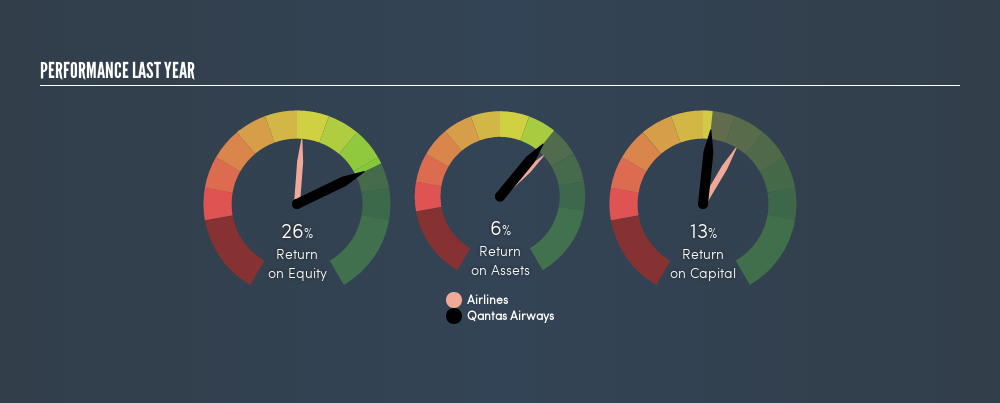What Can We Make Of Qantas Airways Limited’s (ASX:QAN) High Return On Capital?

Today we are going to look at Qantas Airways Limited (ASX:QAN) to see whether it might be an attractive investment prospect. To be precise, we'll consider its Return On Capital Employed (ROCE), as that will inform our view of the quality of the business.
First of all, we'll work out how to calculate ROCE. Then we'll compare its ROCE to similar companies. Last but not least, we'll look at what impact its current liabilities have on its ROCE.
Return On Capital Employed (ROCE): What is it?
ROCE is a measure of a company's yearly pre-tax profit (its return), relative to the capital employed in the business. Generally speaking a higher ROCE is better. Overall, it is a valuable metric that has its flaws. Author Edwin Whiting says to be careful when comparing the ROCE of different businesses, since 'No two businesses are exactly alike.'
So, How Do We Calculate ROCE?
Analysts use this formula to calculate return on capital employed:
Return on Capital Employed = Earnings Before Interest and Tax (EBIT) ÷ (Total Assets - Current Liabilities)
Or for Qantas Airways:
0.13 = AU$1.4b ÷ (AU$19b - AU$7.9b) (Based on the trailing twelve months to December 2018.)
Therefore, Qantas Airways has an ROCE of 13%.
Check out our latest analysis for Qantas Airways
Is Qantas Airways's ROCE Good?
ROCE can be useful when making comparisons, such as between similar companies. Qantas Airways's ROCE appears to be substantially greater than the 10% average in the Airlines industry. We consider this a positive sign, because it suggests it uses capital more efficiently than similar companies. Regardless of where Qantas Airways sits next to its industry, its ROCE in absolute terms appears satisfactory, and this company could be worth a closer look.

When considering this metric, keep in mind that it is backwards looking, and not necessarily predictive. ROCE can be deceptive for cyclical businesses, as returns can look incredible in boom times, and terribly low in downturns. ROCE is, after all, simply a snap shot of a single year. What happens in the future is pretty important for investors, so we have prepared a free report on analyst forecasts for Qantas Airways.
What Are Current Liabilities, And How Do They Affect Qantas Airways's ROCE?
Current liabilities include invoices, such as supplier payments, short-term debt, or a tax bill, that need to be paid within 12 months. Due to the way ROCE is calculated, a high level of current liabilities makes a company look as though it has less capital employed, and thus can (sometimes unfairly) boost the ROCE. To counter this, investors can check if a company has high current liabilities relative to total assets.
Qantas Airways has total liabilities of AU$7.9b and total assets of AU$19b. As a result, its current liabilities are equal to approximately 42% of its total assets. With this level of current liabilities, Qantas Airways's ROCE is boosted somewhat.
What We Can Learn From Qantas Airways's ROCE
While its ROCE looks good, it's worth remembering that the current liabilities are making the business look better. There might be better investments than Qantas Airways out there, but you will have to work hard to find them . These promising businesses with rapidly growing earnings might be right up your alley.
If you like to buy stocks alongside management, then you might just love this free list of companies. (Hint: insiders have been buying them).
We aim to bring you long-term focused research analysis driven by fundamental data. Note that our analysis may not factor in the latest price-sensitive company announcements or qualitative material.
If you spot an error that warrants correction, please contact the editor at editorial-team@simplywallst.com. This article by Simply Wall St is general in nature. It does not constitute a recommendation to buy or sell any stock, and does not take account of your objectives, or your financial situation. Simply Wall St has no position in the stocks mentioned. Thank you for reading.
About ASX:QAN
Qantas Airways
Provides air transportation services in Australia and internationally.
Moderate growth potential second-rate dividend payer.
Similar Companies
Market Insights
Community Narratives


